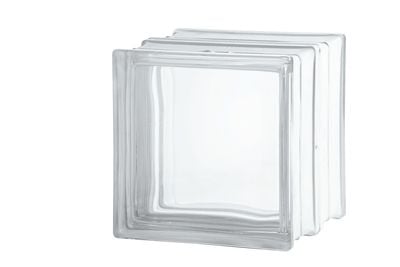Glass Block, The Ideal Windscreen and Rainscreen
As a building material, glass block is durable, sustainable, fire-resistant, and a strong insulator. Its transparent quality supports energy efficiency by allowing light in while softening outside noise. Used as cladding for new construction, glass blocks combine beauty and performance, making them a widely adopted material in architecture around the world.
You might wonder if glass blocks can be used outdoors. Thanks to their distinct properties, they’re now applied in more than just traditional wall systems. A standout use is in glass block rainscreens, which offer protection against wind-driven rain and excess moisture. This application not only shields the structure but also adds a unique design element. With a wide selection of patterns, styles, and shapes, glass block is a versatile and customizable choice for any project.
What is a Rainscreen?
Accumulated moisture resulting from hard rains, ice, and snow is a significant threat to any construction. As moisture penetrates the outer cladding, it tends to accumulate within the walls without draining or evaporating. As a result, the wall substrate of the structure weakens and speeds up deterioration and structural problems. Concrete and brick are highly permeable building materials. They are prone to moisture penetration and accumulation beneath their exterior surfaces. The mortar joints of these materials are typically plaster and will crack or separate over time. This cracking within the mortar joint can also create a path for moisture to penetrate.
Wood siding often cracks from temperature changes and freeze-thaw cycles, thereby leaving gaps for moisture to gain entry. Also, exterior walls are most vulnerable at junctions around windows, doorways, and eaves that are not adequately sealed. Natural building movement and settling will also create cracks and separations that can admit moisture.
To counter the adverse effects of moisture penetration, builders are applying glass block rainscreens that constitute an additional exterior layer separated by a small gap or airspace. The glass block rainscreens' spacing is designed to provide a capillary break that allows drainage and evaporation if moisture should penetrate the exterior surface.
While most rainwater will merely bounce off, as in the case of a glass block exterior cladding, the rainscreen exterior surface breaks the force of sideways, wind-driven water movement, so that any water that gets through breaches in the surface has lost its momentum.
How Does the Glass Block Rainscreen Work?
Creating a completely watertight building with most materials is virtually impossible without employing some offsetting strategies. The objective of effective glass block rainscreens is to create an envelope that keeps moisture from penetrating beneath the primary cladding into the inner wall structure. Glass block rainscreens should be installed to allow a gap, approximately 1/8” to let gravity drain moisture away to flow easily downward without contact with the inner cladding. Weep holes must be added at the base of the structure to allow moisture to escape entirely. In many cases, further protection can be achieved by adding a weather-resistant barrier layer beneath the glass block rainscreens to further repel any stray drops.
What is a Windscreen?
Windscreens are public transportation shelters that provide protection for transit riders. Transit, in this case, being busses and trains. They can be found in urban, suburban, and rural areas across the nation. These stations and shelters are the first contact a rider has with a transit service, therefore, it is important that the shelters meet the needs of the riders. There are several concerns transit stations must keep in mind when building a new shelter/windscreen. The most important being the safety and security of the transit riders. They must also keep in mind the local traffic flow and the overall performance of the transit system.
The safety and security of the passengers waiting must be the number one priority for the systems. A few features that allow riders to feel more secure in the environment is good lighting, visibility to and from the street, location in relation to traffic, and how well the station is maintained. By using glass block in these stations, it can allow for pedestrians to feel more secure in any environment that the windscreen is built. Depending on which block is selected for the windscreen, additional safety features are available.
Why Protect with Glass Block Rainscreens?
Draining downward and away from the inner surface assures that the moisture will not reach the less durable wall assembly structure within. The extra layer and gap act as a raincoat by keeping everything within completely dry. Allowing the moisture to escape or evaporate without lingering within the walls is crucial.
Durable glass block is an ideal option for protecting any building. Because moisture does not penetrate glass block, the material can be used for many exterior applications. Furthermore, unlike pane glass, condensation does not occur either. As a result, tightly sealed glass block is very popular for basement windows that are extremely vulnerable to accumulated snow and water.
Architects around the world are using glass block as the primary exterior material for the world’s unique and beautiful structures. Glass block is beautiful, energy efficient, and prevents water penetration and leakage. Once installed, there is virtually no space between the individual units. The blocks are joined with a specially designed mortar or silicone material that does not crack and is water resistant.
The Versatility of Glass Block
 Glass block is non-conductive, water repellent and, because of its transparency, light admitting material. These properties make glass block the most energy efficient building material available, ideal for glass block rainscreens and windscreens. The same durability and water resistant properties that work well for glass block rainscreens construction allow glass block to work well for interior walls, floors, and stairways. Glass block wind and rainscreens are great in applications where passage of light or ability to see your surroundings is needed. With transparent glass block patterns available, it makes glass block the perfect application in transit stations to allow pedestrians protection from outdoor elements while still having the ability to see their surroundings.
Glass block is non-conductive, water repellent and, because of its transparency, light admitting material. These properties make glass block the most energy efficient building material available, ideal for glass block rainscreens and windscreens. The same durability and water resistant properties that work well for glass block rainscreens construction allow glass block to work well for interior walls, floors, and stairways. Glass block wind and rainscreens are great in applications where passage of light or ability to see your surroundings is needed. With transparent glass block patterns available, it makes glass block the perfect application in transit stations to allow pedestrians protection from outdoor elements while still having the ability to see their surroundings.
Contact GBA Architectural Products & Services
GBA Architectural Products & Services is a North American supplier of world-class glass block materials for interior and exterior applications. For over 30 years, the company has collaborated with professional builders and homeowners with many unique structural glass products that render beautiful and economical functionality in a broad range of scenarios. With our expertise and knowledge in the glass block industry, we are the perfect partner to have when designing any structural glass floor or glass block wall.
GBA glass block products have been used in office designs, exterior claddings, walkways, and stairways throughout North America to admit natural light while optimizing the use of interior space. We are also the proud owners of GlassWalk™ Glass Floor Systems, formerly an IBP product, which includes the structural glass floor system, glass paver system, and glass stair tread system. Additionally, GBA offers a wide selection of glass block and glass brick applications to create the perfect accent wall in any space.
For more information about glass block architecture for offices or other applications, like a vaulted sidewalk, contact GBA Architectural Products & Services.
Visit theGBA website or phone:
- Midwest -(877)-280-7700
- East Coast -(212)-255-5787
- West Coast –(213)-634-7450


